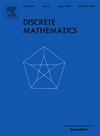On intersecting families of subgraphs of perfect matchings
IF 0.7
3区 数学
Q2 MATHEMATICS
引用次数: 0
Abstract
The seminal Erdős–Ko–Rado (EKR) theorem states that if is a family of k-subsets of an n-element set X for such that every pair of subsets in has a nonempty intersection, then can be no bigger than the trivially intersecting family obtained by including all k-subsets of X that contain a fixed element . This family is called the star centered at x. In this paper, we formulate and prove an EKR theorem for intersecting families of subgraphs of the perfect matching graph. This can be considered a generalization not only of the aforementioned EKR theorem but also of a signed variant of it, first stated by Meyer [9], and proved separately by Deza–Frankl [3] and Bollobás–Leader [1]. The proof of our main theorem relies on a novel extension of Katona's beautiful cycle method.
求助全文
约1分钟内获得全文
求助全文
来源期刊

Discrete Mathematics
数学-数学
CiteScore
1.50
自引率
12.50%
发文量
424
审稿时长
6 months
期刊介绍:
Discrete Mathematics provides a common forum for significant research in many areas of discrete mathematics and combinatorics. Among the fields covered by Discrete Mathematics are graph and hypergraph theory, enumeration, coding theory, block designs, the combinatorics of partially ordered sets, extremal set theory, matroid theory, algebraic combinatorics, discrete geometry, matrices, and discrete probability theory.
Items in the journal include research articles (Contributions or Notes, depending on length) and survey/expository articles (Perspectives). Efforts are made to process the submission of Notes (short articles) quickly. The Perspectives section features expository articles accessible to a broad audience that cast new light or present unifying points of view on well-known or insufficiently-known topics.
 求助内容:
求助内容: 应助结果提醒方式:
应助结果提醒方式:


